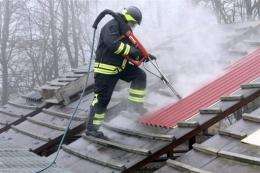Swedish hi-tech 'snake' blazes trail to safer firefighting

Firefighting, arguably one of the world's most dangerous jobs, is about to get a lot safer thanks to a revolutionary technique developed in Sweden.
Boraas, a small town in the southwest of the Scandinavian country, is leading the way in changing how firefighters tackle a blaze using a new design twist on the old-fashioned fire hose.
Known as the Cobra and developed by a local company, the new equipment has already drawn some 7,000 firemen from around the globe for training to this station 60 kilometres (40 miles) from Gothenburg -- including the response teams from the recent Athens and Beijing Olympic Games.
Chief station officer Krister Palmkvist is the man in charge of Cobra training.
"I became a firefighter because I wanted to do good for society, to help people," he said of the time he signed up 38 years ago. "I think it was also about the idea of excitement as well."
Today in his 50s, Palmkvist, who also runs courses aimed at increasing safety awareness among firefighters, has trained colleagues from Paris to Perth and Hamburg to Hong Kong on the Swedish-developed system, now present in more than 30 countries worldwide.
Shaped like a watergun and slung over the shoulder, the Cobra weighs between 10 and 15 kilograms (22 to 33 pounds) and pumps around 60 litres (15 gallons) of water a minute at a pressure of 300 bars.
It spits out a water and ion oxide mix with such velocity that it can slice through steel doors or stone walls.
"The Cobra takes five to six seconds to go through five centimetres (two inches) of concrete," Palmvist said.
Hence its name. Inventor Lars Larsson said it was coined some nine years ago at a press demonstration at the World Fire Show in Germany, where an American journalist likened an early prototype to the venomous snake.
"She said to me, 'this piece of equipment really spits and cuts like a cobra. I think I will call it the Swedish Cobra'," Larsson recalled.
Imagine a burning building full of poisonous gas with temperatures soaring up to 600 degrees Celsius (1112 Fahrenheit). Would you want to step inside?
By piercing a minute hole in the wall or door of a burning building, the firefighter can attack the fire from outside and reduce the flow of oxygen to the danger zone.
-- They said it took away the 'glamour'--
-----------------------------------------
"This form of attack is more effective as we now only need two firefighters to do the job of five. They can start to extinguish it without even having to enter the building," Palmkvist said.
The other firefighters can be deployed elsewhere preparing other equipment or doing tasks, he explained.
The technique also cuts the risk of creating an eruptive effect known as a "backdraft".
Fires require both fuel and oxygen to continue burning, so if a fire breaks out in a closed area, it may use up the entire supply of oxygen before running out of flammable objects to use as its fuel.
If a fire is starved of oxygen, it will try and draw more in by any means possible. A fresh supply will heat up volatile gases inside the burning room or building, causing an instant explosion.
The firefighter injects the pressurised water into the danger zone, creating a cool mist that brings down the temperature of the smouldering room.
"In the beginning, (the Cobra) was seen as just a control method but we realised very quickly that it could be also used as a means of putting out a fire," said Bo Andersson, the senior fire fighting expert with the Swedish Contingency Agency, the central government authority for rescue services.
Most fire services still use the traditional pump and hose method, the standard equipment of choice for almost 90 years. A hose pumps out 435 litres a minute but its jet stream is much less concentrated.
"Why do we still use this system? Only 10 percent of the water is effective." Palmkvist said. "More water is used but it is less accurate."
The Cobra also reduces the amount of water damage, which can be more costly than that from a fire, he added.
Not all of Palmkvist's pupils were keen on the Cobra when they first tried it out. Many, he said, complained that it took away the "glamour" of being a firefighter. "They said, 'you take away the fun, the dangerous part of our job'."
Christian Karlsson, a foreman at Boraas, admitted that he and his colleagues were at first "sceptical" about using the new equipment.
"We are quite conservative in the fire department, but after using it in a number of incidents we are very pleased with it...you can use it on many different surfaces," he said.
"It's a useful thing to have in our toolbox."
(c) 2009 AFP

















